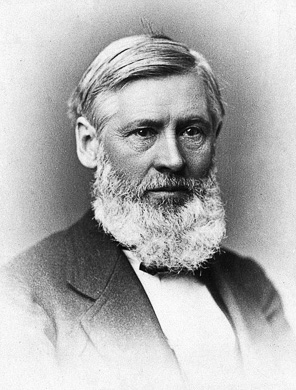BOTANY FOR YOUNG PEOPLE AND COMMON SCHOOLS
How Plants Grow
A Simple Introduction to Structural Botany
by Asa Gray
Originally published in 1858 and now in the public domain.
CHAPTER I.
HOW PLANTS GROW, AND WHAT THEIR PARTS OR ORGANS ARE.
SECTION II. -- How Plants grow from the Seed.
24. Illustrated by the Morning-Glory. We now know what all the parts of a plant are; that a plant, after growing or vegetating awhile, blossoms; that flowers give rise to fruit; that the fruit contains one or more seeds; and that the essential part of a seed is the embryo or germ of a new plant.
To produce, protect, and nourish this germ is the object of the flower, the fruit, and the seed.
The object of the embryo is to grow and become a new plant. How it grows is what we have now to learn.
25. Life in a Seed. But first let us notice that it does not generally grow at once.
Although alive, a seed may for a long while show no signs of life and feel neither the summer's heat nor the winter's cold. Still it lives on where it falls, in this slumbering way, until the next spring in most plants, or sometimes until the spring after that, before it begins to grow.
There is a great difference in this respect in different seeds. Those of Red Maple ripen in the spring, and start about the middle of the summer. Those of Sugar Maple ripen in the fall, and lie quiet until the next spring. When gathered and laid up in a dry place, many seeds will keep alive for two, three, or several years; and in this state plants may be safely transported all around the world.
How long seeds will live is uncertain. The stories of seeds growing which have been preserved for two or more thousand years with Egyptian mummies are not to be believed. But it is well known that Sensitive Plants have been raised from seeds over sixty years old. Few kinds of seeds will grow after keeping them for five or six years; many refuse to grow after the second year; and some will not grow at all unless allowed to fall at once to the ground. There is no way of telling whether the germ of a seed is alive or not, except by trying whether it will grow, that is, will germinate.
26. Germination and Early Growth. Germination is the sprouting of a plant from the seed.
Having just illustrated the parts of a plant by the Morning-Glory, from the root up to the seed and the embryo in the seed, we may take this same plant as an example to show how a plant grows from the seed. If we plant some of the seeds in a flower-pot, covering them lightly with soil, water them, and give them warmth, or if in spring we watch those which sowed themselves naturally in the garden the year before, and are now moistened by showers and warmed by sunshine, we shall soon see how they grow.
And what we learn from this one kind of plant will be true of all ordinary plants, but with some differences in the circumstances, according to the kind.
27. The seed first imbibes some moisture through its coats, swells a little, and, as it feels the warmth, the embryo gradually wakes from its long and deep sleep, and stretches itself, as it were. That is, the tiny stem of the embryo lengthens, and its end bursts through the coats of the seed; at the same time, the two leaves it bears grow larger, straighten themselves, and so throw off the seed-coats as a loose husk; this allows the seed-leaves to spread out, as leaves naturally do, and so the seedling plantlet stands revealed.
Observe the whole for yourselves, if possible, and compare with these figures.
Fig. 19 is repeated from p. 9, and represents the embryo taken out of the seed, straightened, enlarged, and the two leaves a little opened.
Fig. 16 and 17 show how the embryo lies snugly packed away in the seed.
Fig. 20 shows it coming up, the seed-leaves above just throwing off the coats or husk of the seed.
Fig. 21 is the same, a little later and larger, with the seed-leaves spread out in the air above, and a root well formed beneath.
And Fig. 22 is the same a little later still.
28. At the very beginning of its growth, the end of the little stem which first comes out of the seed turns downward and points into the earth. From it the root is formed, which continues downwards, branching as it grows, and burying itself more and more in the soil. The other end of the stem always turns upwards, and, as the whole lengthens, the seed-leaves are brought up out of the ground, so that they expand in the light and air, which is the proper place for leaves, as the dark and damp soil is for the root.

29. What makes the root always grow downwards into the ground, and the stem turn upwards, so as to rise out of it, we no more know, than we know why newly-hatched ducklings take to the water at once, while chickens avoid it, although hatched under the same fowl and treated just alike. But the fact is always so.
And although we know not how, the why is evident enough; for the root is thereby at once placed in the soil, from which it has to absorb moisture and other things, and the leaves appear in the air and the light, where they are to do their work.
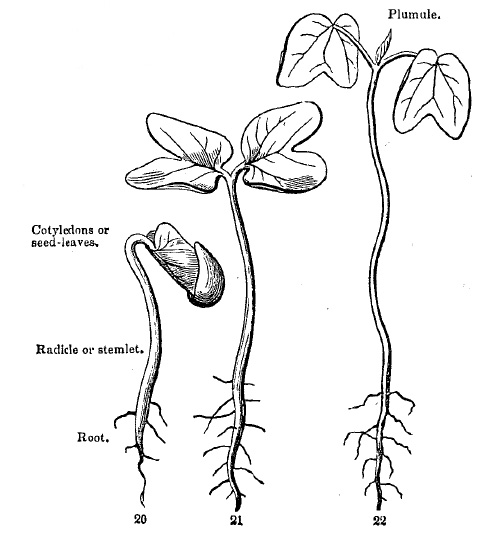
30. Notice how early the seedling plant is complete, that is, becomes a real vegetable, with all its parts, small as the whole thing is (Fig. 21).
For it already possesses a root, to connect it with the ground and draw up what it needs from that; a stem, to elevate the foliage into the light and air; and leaves, to take in what it gets directly from the air, and to digest the whole in the light (as explained in the last section, Par. 7). That is, it already has all the Organs of Vegetation (Par. 1), all that any plant has before blossoming, so that the little seedling can now take care of itself, and live, just as any larger plant lives, upon the soil and the air.
And all it has to do in order to become a full-grown plant, like Fig. 4, is to increase the size of its organs, and to produce more of them, namely, more stem with more leaves above, and more roots below. We have only to watch our seedling plantlets a week or two longer, and we shall see how this is done.
31. The root keeps on growing under ground, and sending off more and more small branches or rootlets, each one adding something to the amount of absorbing surface in contact with the moist soil. The little stem likewise lengthens upwards, and the pair of leaves on its summit grows larger. But these soon get their full growth; and we do not yet see, perhaps, where more are to come from.
But now a little bud, called the Plumule, appears on the top of the stem (Fig. 22), just between the stalks of the two seed-leaves; it enlarges and unfolds into a leaf; this soon is raised upon a new piece of stem, which carries up the leaf, just as the pair of seed-leaves were raised by the lengthening of the radicle or first joint of stem in the seed.
Then another leaf appears on the summit of this joint of stem, and is raised upon its own joint of stem, and so on. Fig. 23 shows the same plant as Fig. 22 (leaving out the root and the lower part of the stem), at a later stage; c,c are the seed-leaves; l is the next leaf, which came from the plumule of Fig. 22, now well raised on the second joint of stem; and l is the next, still very small and just unfolding.
And so the plant grows on, the whole summer long, producing leaf after leaf, one by one, and raising each on its own joint of stem, arising from the summit of the next below; as we see in Fig. 4, at the beginning of the chapter, where many joints of stem have grown in this way (the first with a pair of leaves, the rest with one apiece), and still there are some unfolding ones at the slender young summit.

32. How the Seedling is nourished at the Beginning. Growth requires food, in plants as well as in animals.
To grow into a plant, the embryo in a seed must be fed with vegetable matter, or with something out of which vegetable matter can be made.
When a plant has established itself, that is, has sent down its roots into the soil, and spread out some leaves in the air, it is then able to change mineral matter (viz., earth, air, and water) which it takes in, into vegetable matter, and so to live and grow independently.
But at the beginning, before its organs are developed and established in their proper places, the forming plant must be supplied by ready-made vegetable matter furnished by the mother plant.
On this supply the embryo germinating from the seed feeds and grows, just as the newborn animal does upon the mother's milk, or as the chick developing in the egg does upon the prepared nourishment the parent had laid up for the purpose in the yolk.
33. Tear open a fresh Morning-Glory seed, or cut a dried one in two, as in Fig. 17, and this supply will be seen, in the form of a rich and sweetish jelly-like matter, packed away with the embryo, and filling all the spaces between its folds.
This is called the Albumen of the seed (that being the Latin name of the white of an egg); and this is what the embryo feeds upon, and what enables its little stemlet (Fig. 18, r) to grow, and form its root downwards, and carry up and expand its seed-leaves (c,c) in the air, and so become at once a plantlet (Fig. 21), with root, stem, and leaves, able to take care of itself, just as a chicken does when it escapes from the shell.
34. This moist nourishing jelly would not keep long in that state. So, when the seed ripens and dries, it hardens into a substance like thin dried glue or gum, which will keep for any length of time. And whenever the seed is sown and absorbs moisture, this matter softens into a jelly again, or gradually liquefies, and the seed-leaves crumpled up among it drink it in at every pore. A portion is consumed in their growth, while the rest is carried into the growing stemlet, thence into the root forming at one end of it, and into the bud (or plumule, Fig. 22) which soon appears at the other end of it, supplying the materials for their growth.
35. Notice the same thing in Wheat, Oats, or Indian Corn. The last is the best example because the grain is so large that all the parts may be clearly seen without magnifying.
The abundant milk or soft and rich pulp of green corn is the same as the jelly in the seed of the Morning-Glory; namely, it is the albumen of the seed, provided for the embryo (the chit or germ) to feed upon when growth begins. See Figures 44, 45, &c.
This nourishing food (as we well know it to be) was produced by the mother-plant during the summer, was accumulated in the stalk at flowering-time, in the form of sugar, or syrup, was conveyed into the flowers and forming seeds; a part was used to form the germ or embryo, and the rest was stored up with it in the seed, to serve for its growth into a plantlet the next spring.
That it may keep through the winter, or longer, the sweet milk is changed into a starchy pulp, which hardens as the grain ripens into the firm and dry mealy part (or albumen), which here makes the principal bulk of the seed.
But when sown, this meal softens and is slowly changed back into sugar again. And this, dissolved in the water the seed takes in, makes a sweet sap, which the embryo imbibes and feeds on as it sprouts.
That the meal or starch of the grain is actually changed into sugar at this time is clearly shown by malting, which is merely causing heaps of grain to sprout a little, and then destroying the life of the embryo by dry heat, when the grain (now malt) is found to be sweet, and to contain much sugar.
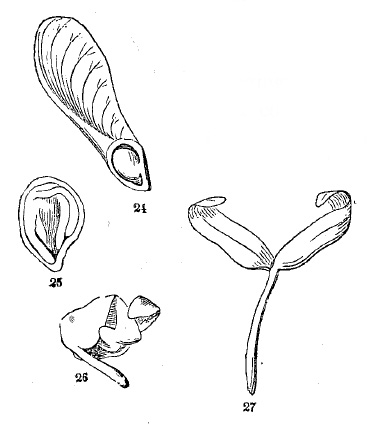
36. The nourishment which the mother-plant provides in the seed is not always stored up outside of the embryo. In many cases it is deposited in the embryo itself, most commonly in the seed-leaves.
Then the seed consists of nothing but the embryo within its coats. Maple-seeds are of this sort.
Fig. 24 represents a seed of Red Maple in the lower part of the winged seed-vessel, which is cut away so as to show it in its place.
Fig. 25 is the seed a little magnified, and with the coats cut away, bringing to view its embryo coiled up within and filling the seed completely.
Fig. 26 is the embryo taken out, and a little unfolded; below is the radicle or stemlet; above are the two seed-leaves partly crumpled together.
Fig. 27 is the embryo when it has straightened itself out, thrown off the seed-coats, and begun to grow. Here the seed-leaves are rather thick when they first unfold; this is on account of the nourishing matter which was contained in their fabric, and which is used mainly for the earliest growth of the radicle or stemlet, and for the root formed at its lower end, as we see in the next figure (Fig. 28: a, the radicle or stemlet of the embryo; b,b, the two seed-leaves; c, the root).
By this time the little stock of nourishment is exhausted. But the plant, having already a root in the soil and a pair of leaves in the air, is able to shift for itself, to take in air, water, &c., and by the aid of sunshine on its foliage to make the nourishment for its future growth. In a week or two it will have made enough to enable the next step to be taken. Then a little bud appears at the upper end of the stemlet, between the two seed-leaves, and soon it shows the rudiments of a new pair of leaves (Fig. 28, d); a new joint of stem forms to support them (Fig. 29); this lengthens just as the stemlet of the embryo did, and so the plantlet gets a second pair of leaves, raised on a second joint of stem springing from the top of the first (Fig. 30).
Meanwhile the root has grown deeper into the soil and sent out branches. Having now more roots below, and, above a pair of leaves besides the seed-leaves to work with, the seedling plantlet all the sooner makes vegetable matter enough to form a third pair of leaves and raise them on a third joint of stem (as in Fig. 31); and so it goes on, step by step.
This nourishment in the embryo of the Red-Maple seed was a few weeks before in the trunk of the mother tree, as a sweet sap, that is, as Maple-sugar.
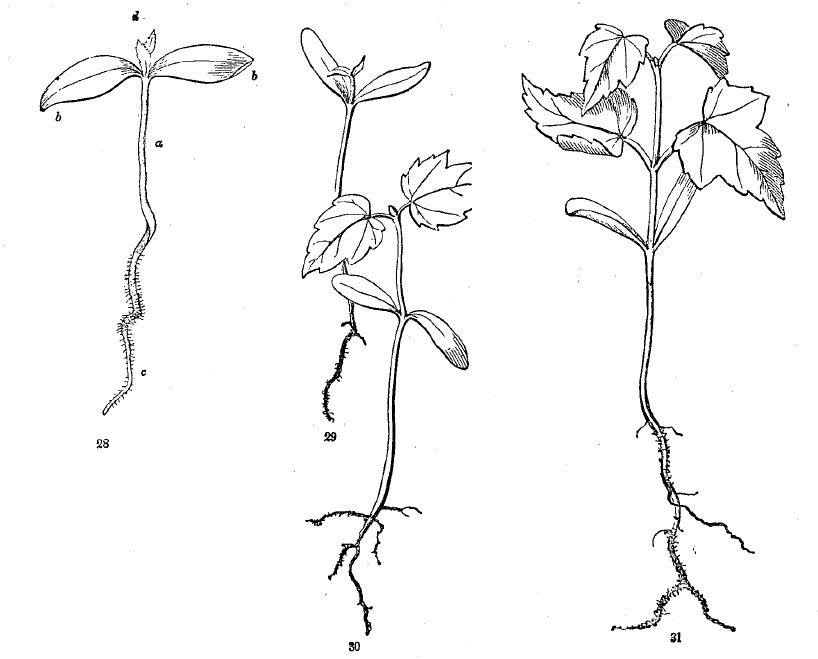
37. Variations of the Plan of Growth.
In the Morning-Glory, after the pair of seed-leaves, only one leaf is found upon each joint of stem (see Fig. 23 and 4). In the Maple there is a pair of leaves to every joint of stem, as long as it grows.
In the Morning-Glory the food in the seed, for the growth to begin with, was stored up outside of the embryo; in the Maple it was stored up in it, that is, in its seed-leaves.
The plan is evidently the same in both; but there are differences in the particulars. While the same kind of plant always grows in exactly the same way, different kinds differ almost as much at the beginning as they do afterwards. The great variety which we observe among the herbs and shrubs and trees around us, in foliage, flower, fruit, and everything, gives to vegetation one of its greatest charms. We should soon tire of plants or flowers made all after one exact pattern, however beautiful. We enjoy variety.
But the botanist finds a higher interest in all these differences than anyone else, because he discerns one simple plan running through all this diversity, and everywhere repeated in different forms. He sees that in every plant there is root growing downwards, connecting the vegetable with the soil; stem rising into the light and air, and bearing leaves at regular places, and then blossoms, and that the parts of one kind of blossom answer to those of another, only differing in shape; and he delights in observing how the tens of thousands of kinds of plants all harmonize with each other, like the parts of concerted music, plainly showing that they were all contrived, as parts of one system, by one Divine Mind.
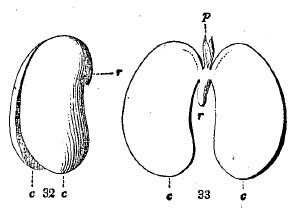
38. So in the beginning, in the growth of plants from the seed, although the general plan is the same in all, the variations are many and great. The plan is well shown in the two seedling plants which have served for illustration, namely, the Morning-Glory and the Maple. Let us now notice some of the variations, as exhibited in a few very common plants.
A great deal may be learned from the commonest plants, if we will only open our eyes to see them, and "consider how they grow," and why they differ in the way they do. Take, for instance,
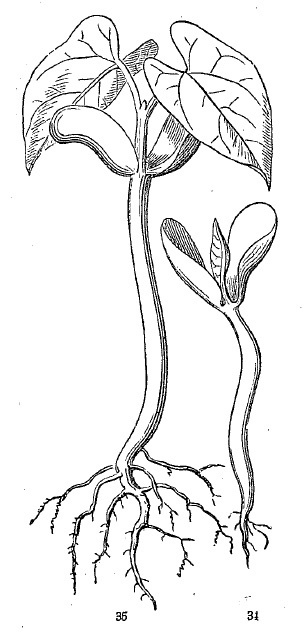
39. The Bean.
Soak a bean in warm water (if a fresh one is not to be had) and remove the coats. The whole kernel consists of an embryo, as seen in Fig. 32. And almost the whole bulk of this embryo consists of two thick pieces, c,c, which are the cotyledons or seed-leaves.
We may make out the plan of the whole thing better by spreading these thick seed-leaves wide open, as in Fig. 33. Here the two thick seed-leaves are seen from the inside, c,c; they are connected with the upper end of a stemlet, which is the radicle, r; and above this already shows the bud or plumule, p.
40. So the embryo of the Bean is the same in plan as that of the Maple (Fig. 27), only the stemlet is much shorter in proportion, and the seed-leaves very much larger and thicker. What is the reason of this difference?
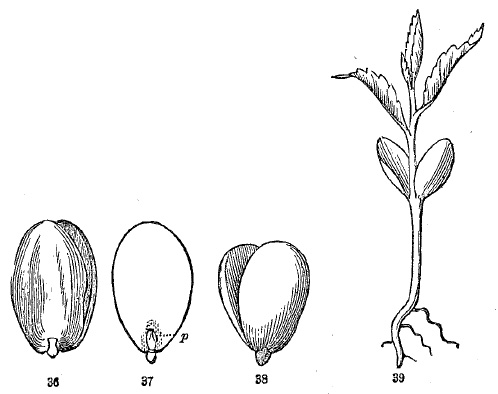
41. The seed-leaves of the Bean are thickened by having so much nourishment stored up in them, so much of it that they make good food for men. And the object of this large supply is that the plant may grow more strongly and rapidly from the seed.
It need not and it does not wait, as the Maple and the Morning-Glory do, slowly to make the second pair of leaves, but is able to develop these at once. Accordingly, the rudiments of these next leaves may be seen in the seed before growth begins, in the form of a little bud (Fig. 33, p), ready to grow and unfold as soon as the thick seed-leaves themselves appear above ground (Fig. 34), and soon making the first real foliage (Fig. 35).
For the seed-leaves of the Bean are themselves so thick and ungainly, that, although they turn green, they hardly serve for foliage. But, having given up their great stock of nourishment to the forming root and new leaves, and enabled these to grow much stronger and faster than they otherwise could, they wither and fall off. It is nearly the same in
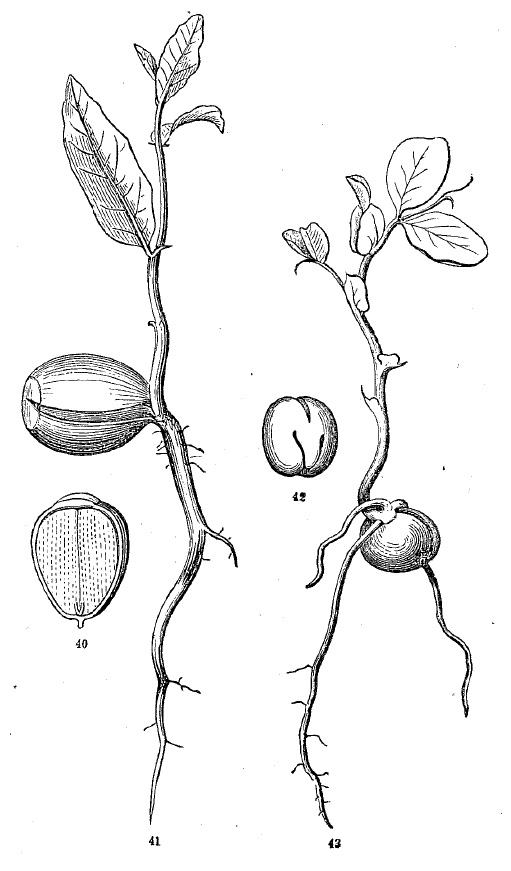
42. The Cherry, Almond, &c.
Fig. 36 is an Almond taken out of the shell, soaked a little, and the thin seed-coat removed. The whole is an embryo, consisting of a pair of large and thick seed-leaves, loaded with sweet nourishment. These are borne on a very short radicle, or stemlet, which is seen at the lower end.
Pull off one of the seed-leaves, as in Fig. 37, and you may see the plumule or little bud, p, ready to develop leaves and stem upwards, while the other end of the radicle grows downward and makes the root; the rich store of nourishment in the seed-leaves supplying abundant materials for the growth.
A cherry-seed is just like an almond, only on a smaller scale. Fig. 38 is the embryo of a Cherry, with the very thick seed-leaves a little separated. Fig. 39 is the same developed into a young plantlet. Fed by the abundant nourishment in the seed-leaves, it shoots up its stem and unfolds three or four leaves before the Maple (Fig. 28, 29) or the Morning-Glory (Fig. 20-22) would have made any.
It is the same in the Chestnut and the Beech. In these, as in the Cherry and the Bean, the thick seed-leaves, which make the whole kernel, come up, turn green, and become thinner as they give up their load of nourishment to the growing parts; they evidently try to become useful green leaves; but having been used for holding nourishment, they remain too thick and clumsy for foliage, and they soon die or fall off.
But in
43. The Horsechestnut, the Acorn, and the Pea,
the seed-leaves are so very thick, and so heavily loaded, that they never undertake to serve any other purpose than that of feeding the other parts as they grow. So they remain in the shell or husk, and, as they are not to rise out of the ground, there is no need for their stemlet, or radicle, to lengthen, except enough to get out of the seed, and let the root form from the lower end of it, while the plumule develops from its upper end directly into a strong leafy stem.
Fig. 40 is an acorn cut through lengthwise. The whole kernel consists of a pair of very thick seed-leaves, loaded with starch, &c., and completely enclosing the very small and short stemlet, or radicle, seen at the bottom.
Fig. 41 is the acorn with the seedling Oak growing from it; the seed-leaves remaining in the shell, but feeding the strong root which grows downwards and the stem which shoots so vigorously upwards.
44. Acorns and horsechestnuts may not always be found germinating; but in the Pea we have a familiar case of this way of growing, which may be observed at any season by planting a few peas.
Fig. 42 is a pea with the seed-coat taken off, after soaking. Here the seed-leaves are so thick that the pair makes a little ball; and the stout radicle or stemlet appears on the side turned to the eye.
Fig. 43 shows the plantlet growing. The whole seed remains in the soil; the plumule, well nourished, by the great stock of food in the buried seed-leaves, alone rises out of the ground as a strong shoot, bearing an imperfect scale-like leaf upon each of its earlier joints, and then producing the real leaves of the plant, while the radicle at the same time, without lengthening itself, sends down three or four roots at once. So the whole plant is quickly established, and all the early growth is made out of food provided for it the year before by the mother plant, and stored up in the seed.
One more illustration we may take from
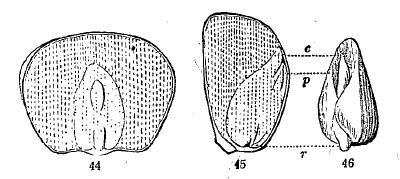
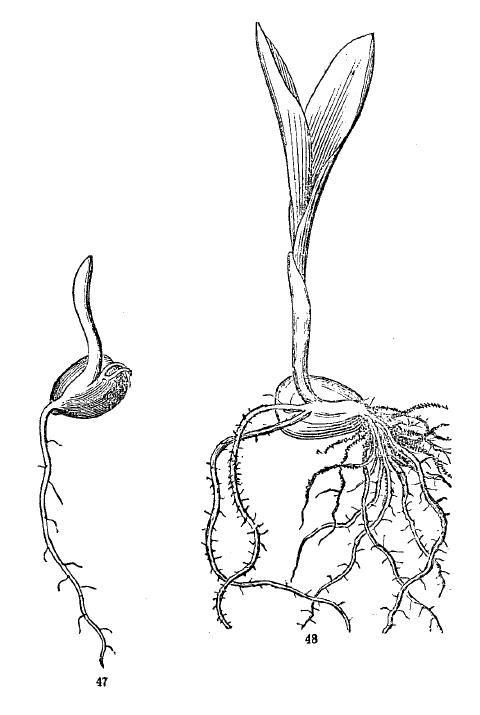
45. Indian Corn.
Here the food provided for the early growth is laid up partly in the embryo, but mostly around it.
Fig. 44 is a grain cut through flat-wise;
Fig. 45, another cut through the middle across its thickness; and
Fig. 46, the embryo, or germ, of another grain, taken out whole, which may readily be done in green corn, or in an old grain after soaking it for some time in warm water. The separate embryo is placed to match that which is seen, divided, in the seed; r is the radicle; p, the plumule; and c, the seed-leaf or cotyledon, which in this plant is single, while in all the foregoing there was a pair of seed-leaves.
The greater part of the grain is the meal, or albumen, the stock of nourishment outside of the embryo. In germinating, this meal is slowly changed into sugar and dissolved in the water which is absorbed from the ground; the cotyledon imbibes this, and sends it into the radicle, r, to make the root, and into the plumule, p, enabling it to develop the set of leaves, wrapped up one within another, of which it consists, and expand them one after another in the air.
Fig. 47 shows a sprouting grain, sending down its first root, and sending up the plumule still rolled together.
Fig. 48 is the same, more advanced, having made a whole cluster of roots, and unfolded two or three leaves. Nourished abundantly as it is, both by the maternal stock in the grain, and by what these roots and leaves obtain and prepare from the soil and the air, the young corn gets a good start, is ready to avail itself of the summer's heat, to complete its vegetation, to blossom, and to make and lay up the great amount of nourishment which we gather in the crop.
46. The Onion. The cotyledon in Indian Corn, and most other plants which have only one, stays under ground.
In the Onion it comes up and makes the first leaf, a slender, thread-shaped one, and indeed it carries up the light seed on its summit.
In Indian Corn, all the early joints of stem remain so short as not to be seen; although later it makes long joints, carrying up the upper leaves to some distance from one another.
In the Onion, on the contrary, the stem never lengthens at all, but remains as a thin plate, broader than it is long, with the roots springing from one side of it and the sheathing bases of the leaves covering it on the other.
47. Number of Cotyledons or Seed-Leaves. Indian Corn (Fig. 46) and all such kinds of grain-plants, the Onion, Lilies, and the like, have only one seed-leaf or cotyledon to their embryo; therefore they are called MONOCOTYLEDONOUS PLANTS, and the embryo is called monocotyledonous, a long word meaning "with one cotyledon."
48. The embryo of the Morning-Glory (Fig. 19), of the Maple (Fig. 27), Bean (Fig. 32-34), Almond, Peach, and Cherry (Fig. 36-38), Oak (Fig. 40), Pea (Fig. 42), and of all such plants, is dicotyledonous, that is, has a pair of cotyledons, or seed-leaves, which is what the word means. Therefore all such plants are called DICOTYLEDONOUS PLANTS.
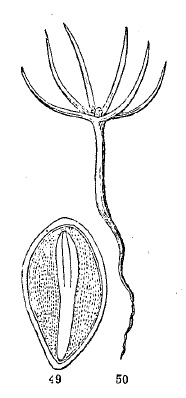
49. Pine-trees, and plants like them, generally have more than two cotyledons, in a circle, so their embryo is said to be polycotyledonous, meaning "with several or many cotyledons."
Fig. 49 is a magnified view of a Pine-seed, divided lengthwise, and showing the long and straight embryo lying in the middle of the albumen. The slender lower part is the radicle or stemlet; the upper part is a cluster of cotyledons or seed-leaves, in a close bundle; three of them can be seen as it lies, and there are as many more behind.
Fig. 50 is this embryo as it comes up from the seed, its cotyledons (six in number) expanding at once into a circle of slender, needle-shaped leaves.
50. It is a pity these three words are so long; for the pupil should fix them thoroughly in his memory; because these differences in the embryo, or plantlet in the seed, run through the whole life of the plant, and show themselves in many other differences which very strikingly distinguish one class of plants from another. Let it be remembered, therefore, that
Monocotyledonous Plants, or Monocotyledons, are those which have only one cotyledon or seed-leaf to their embryo.
Dicotyledonous Plants, or Dicotyledons, are those which have a pair of cotyledons or seed-leaves to their embryo.
Polycotyledonous Plants, or Polycotyledons, are those which have more than one pair of cotyledons or seed-leaves to their embryo.
Analysis of the Section.
24. Flowers produce Fruit; this, the Seed; of this the essential part is the Embryo which grows. 25. It is alive; but lies dormant awhile. How long seeds may live.
26. Germination, the beginning of growth; what is needful for it. 27. What takes place, illustrated from the Morning-Glory. 28. How the stemlet grows by lengthening and carries up the seed-leaves; how the root is formed and grows downwards. 29. Instinct of each part to turn in its proper direction and why. 30. The little seedling a complete plant in miniature; its parts. 31. How it goes on to grow; growth of the root, rootlets, the stem. The Plumule or Bud. Development of the stem piece by piece, each with its leaf.
32. How the seedling is nourished at the beginning. Growth requires food. 33. How this is supplied by a deposit in the seed; Albumen. 34. It is kept in a solid form until the embryo starts, and is then dissolved, turned into sugar, &c., and feeds the plantlet. 35. This illustrated in Wheat and Indian Corn. 36. Or else the same nourishment is deposited in the embryo itself, in its seed-leaves; illustrated by the Maple. 37, 38. Variations of the same plan of growth in different plants. The Maple compared with the Morning-Glory. 39-45. A great abundance of food stored up in the embryo causes a rapid and strong growth; illustrated by the Bean; 42. by the Cherry, Almond, &c.; 43, 44. by the Horsechestnut, Acorn, Pea, &c.; in these the seed-leaves do not come up in germinating; why. 45. In Indian Corn; the stock of food partly in the strong embryo, partly outside of it. 46. The Onion; its seed-leaf lengthens and comes up, but the stem never lengthens at all.
47. Number of cotyledons or seed-leaves in different kinds of plants; Monocotyledonous. 48. Dicotyledonous; Polycotyledonous. 50. These differences always accompany other differences in the plant; Monocotyledonous, Dicotyledonous, and Polycotyledonous Plants.

